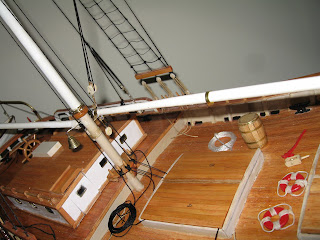
Tuesday, April 21, 2009
Tuesday, April 7, 2009
 She's nearly done. This sailing ship is hand-fashioned after the North American Merchant Schooner of the late 1800's. These ships were used for carrying goods along the East Coast of the United States. and South America.
She's nearly done. This sailing ship is hand-fashioned after the North American Merchant Schooner of the late 1800's. These ships were used for carrying goods along the East Coast of the United States. and South America.I recommend you click on the photos to enlarge the detail.
 It looks so real!
It looks so real! The bowsprit is inlaid with ivory diamond shapes and a star on the very front.
The bowsprit is inlaid with ivory diamond shapes and a star on the very front.
A view of the midships, looking forward. This shows off some of the curves in the boat design. The hatch coamings are raised to support the hatch covers which give access to the interior holds. Note the oak planking of the deck.

Aerial view of the stern shows the lifeboat, suspended from its davits. The davits are fashioned of brass with miniature pulleys that raise and lower the boat. Notice the life ring and fire axe atop the house.

All the rope work is hand-tied. The ivory rope blocks in the foreground are used to tighten the mast stays. They are authentic miniatures and absolutely work.

In the foreground, at the rail you can see cleats and rope chocks, carved by hand and painted black. There are a total of 12 cleats on the boat and 8 chocks.

This shows a portion of the living quarters below the removable house. See the barrel on the deck? The cooper is not finished with it yet.
 Below decks you can see the step of the mast and the inside framing. Note the anchor winch (it really weighs the anchor and is turned by hand.)
Below decks you can see the step of the mast and the inside framing. Note the anchor winch (it really weighs the anchor and is turned by hand.) See how the mast and bowsprit line up with the keel. She's true, and straight as an arrow.
See how the mast and bowsprit line up with the keel. She's true, and straight as an arrow. Elegant shape.
Elegant shape.New photos, and these will be some of the last ones before it's finished. The boat will go up for sale in the near future. It represents some 6 months of steady work. Remember, all the parts and pieces are made by hand and, with the exception of things like, say, the bell, all is hand-fashioned. Look closely at the blocks and tiny fittings. Some are made of ivory, but all are handmade and really work. Ropes and pulleys, rudder and steering wheel, doors, etc. are all functional.
Captain Ron is listed with the Department of the Interior - Indian Arts and Crafts Board. A member of the Alutiq Tribe of the Koniag Island Group (Kodiak) of Alaska.
Please direct any inquiries to:
Subscribe to:
Comments (Atom)










